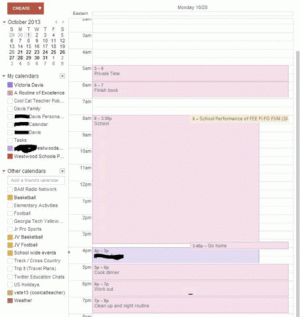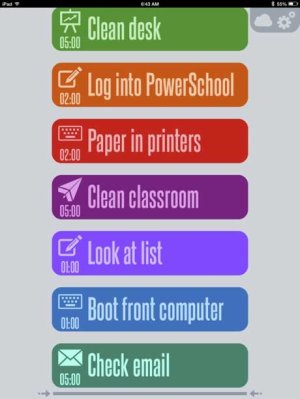Habits of Mind for the New Year: 10 Steps to Actually Accomplish Your Resolutions
While 45 percent of people make New Year's resolutions, only 8 percent of that group report achieving their resolutions. Why do so many fail? What can we do to increase our odds of accomplishing these all-important goals? In this blog, I'll share some of the tricks and apps that have helped me accomplish my resolutions for the past four years.
Set Your Goal
Step 1: Name Your Year
Name your year with a mantra or purpose statement. I've celebrated "the year of the habit," which I focused on making good habits, and "the year of intentional living," where I reexamined every commitment.
Step 2: Name Your Goal
Effective goals are specific, measurable, achievable, realistic and time-bound. Stephen Covey always added that they were also "owned" through the specific decision to achieve them. This is important for students, because it must be their goal, not their parents' or teacher's.
Step 3: Put Your Decision in Writing
Internalize your goals by writing them down. You don't need to call it resolution. Find a favorite method for keeping short-, medium- and long-term sets of goals according to the method of your choice. Type it into your electronic notebook. Record yourself reading it on your phone. Listen to your plans every day during January. You become what you think about most of the time. If your goal never crosses your mind, it won't cross your calendar, either. Habits are powerful, so write it down!
Step 4: Evaluate Your Goal
- Does it fit with your purpose? (Jon Acuff discusses knowing your purpose.)
- Have any negative habits caused this goal to become necessary?
- What would you give up to make this goal happen?
- Is this goal worth a year of your life to achieve?
- If you have more than one goal, prioritize them and start with the first one.
Set Your Habits
A habit is a regular practice. You don't have to think about habits. They're just what you do. You can improve or replace habits you don't like, because they won't go away on their own. When you establish a habit, the mind doesn't have to work so hard, and you’re free to create new ones. Work on one new thing at a time until it becomes automatic.
Step 5: Find the Habits to Achieve Your Goal
Too many of us believe those who are successful are just "lucky" when it actually required hard work. Start by finding people whose circumstances are similar to yours but who've achieved the success you desire. They are your pattern.
As teachers, we use patterns every day -- they're called lesson plans. As part of my January goal-setting lessons, students research and create presentations about those they admire who have a success that they aspire to reach. The presentation, however, is not about the accomplishments but requires students to explain at least three habits that the person used to achieve their goals. Two of those habits must be before they were "famous." Emphasize to students that, rather than copying personal mannerisms, they should consider emulating habits. As Brian Tracy says, “We form our habits, and then our habits form us."
Step 6: Assess Time Needed for Specific Habits
People who want to lose weight often say, "I'll exercise more and eat less." What does that look like? How many calories? How often will you exercise? When will you weigh and what kind of accountability group will you join? Remember that negative habits are part of your life, too. You can’t just eliminate them -- you need to replace them with something else. And that takes time.
Step 7: Calendar Your New Habits
I made a private Google Calendar called "A Routine of Excellence" where I schedule appointments with myself based upon my goals for the year. Reschedule key habits -- never delete them.
7a. Schedule Large Habits
Focus on building one large habit at a time until it is permanent by setting appointments with yourself each week. If it takes longer than 15 minutes (working out, quiet time in the morning, an hour of reading), put it on the calendar.

7b. Aggregate Smaller Key Habits
Small habits chained together are a routine. Build routines by using apps like 30/30 or HomeRoutines to create small sets of routines at key times in the day. Keep the routines to 15 minutes or less, and add only one at a time until it becomes habit. Some of these routines will have key habits related to your goal (a glass of water first thing does help weight loss), but others will just help you smooth out your day. Be intentional about the routines and habits you choose.

Step 8: Set Up Visual Cues and Trigger Environments
If you'll be exercising at work, then your evening routine should include packing your workout clothes. If you're using a FitBit, Jawbone or another health-tracking gadget, schedule a weekly charge. Make it easy to do your habit by removing your excuses. If you write with a candle burning, leave the spent matches to tally your sessions per week.

Step 9: Enlist a Support Group
The Lift, Lose It and Fitocracy apps let you link with others to mutually encourage accomplishing various habits. Never underestimate the power of a face-to-face support group, particularly if (like me) you struggle with weight or any other hard-to-tackle problem that comes from negative habits.
Step 10: Adapt and Reset
Four years ago, I set and met a goal to lose 35 pounds by joining with a group. Last year, I permanently injured my knee and can no longer run. I promptly gained back the weight I had lost, but I won't count it as a failure because circumstances change over time. Don’t treat your 40-year-old body like a 20-year-old body. Give yourself a fresh start with no guilt.
Count the Cost and Resolve to Change
The Arbinger Institute's Leadership and Self-Deception tells us that "by being in the box, I provoke others to be in the box." As teachers, we teach with our lives. Our habits become models to the children who look up to us. If we choose to stay fat, for example, we lead others to do the same. Conversely, if we choose to move forward and get out of our box, whatever it is, others will follow.
You are what you think and what you do every day. Resolutions may be made in a day, but habits take a lifetime. First you make your habits, then your habits make you. Start building a new life today by building your habits.
Make this New Year your year of the habit. Choose wisely, for you are making your destiny one day at a time.
Recommended Reading
- Problogger by Darren Rouse and Chris Garrett
- The War of Art by Stephen Pressfield
- Manage Your Day-to-Day by Jocelyn Glei
- Platform by Michael Hyatt
- Teach Like a Pirate by Dave Burgess
- Fred Jones Tools for Teaching by Fred Jones
- The Power of Habit by Charles Duhigg
